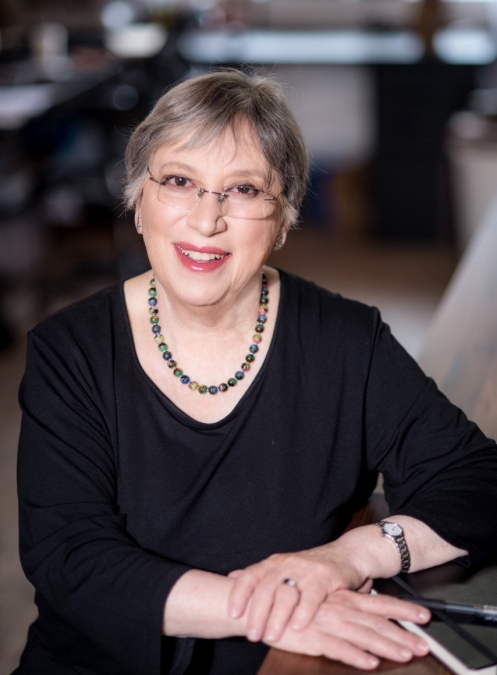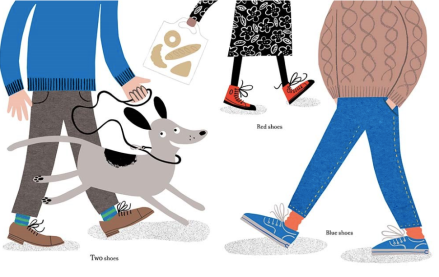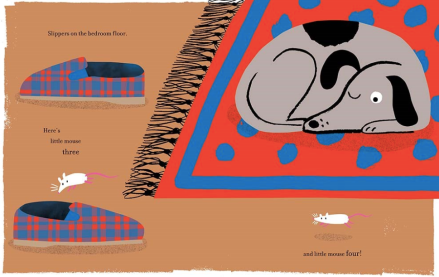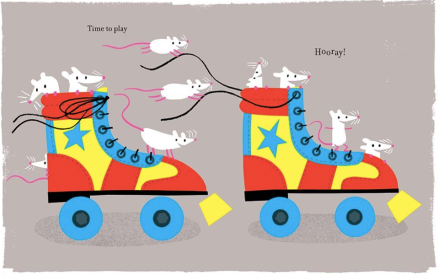 About the Holiday
About the Holiday
This month-long holiday encourages families to spend time together having fun, learning, and getting to know each other on an all-new level. Having a baby in the family means there are plenty of joyous moments and new experiences to enjoy as the little one learns about the world and their place in it. For children any moment—whether while playing, shopping, or doing chores—can become an exciting and enjoyable opportunity for discovery. Reading together is one of the best ways to nurture a baby’s development—as you’ll see in today’s book!
I received a copy of LOOK! Babies Head to Toe from Abrams Appleseed for review consideration. All opinions are my own. I’m happy to be teaming with Abrams Appleseed in a giveaway of the book. See details below.
LOOK! Babies Head to Toe
Written by Robie H. Harris | Illustrated by Anoosha Syed
With a baby on your lap or cuddled up beside you, you can open the world of self-awareness for your child as you open the cover of this engagingly written and adorably illustrated board book. Little readers will be immediately entranced by the baby who smiles out at them from the first pages as adults exclaim, “Look! A baby!,” show them the baby “Head to toe! Toe to head!” and share a greeting: “Hi, baby!”

Image copyright Anoosha Syed, 2019, text copyright Robie Harris, 2019. Courtesy of Abrams Appleseed, Abrams Books for Young Readers.
What baby doesn’t love playing peek-a-boo? Here, babies learn about eyes by playing along with the enthusiastic baby in the book who hides his eyes and then reveals them with a happy smile. What are ears for? Listening, of course! And as the sweet baby on the page listens to her mom play the ukulele, your baby hears “Look! Baby’s ears!” and can be encouraged to repeat “La-la-la!”
Noses are for smelling, but sometimes they’re for sneezing too—“Ah-choo!” Turn the page again and “Look! A baby! Look! Baby’s mouth” is puckered up for a kiss. Moving on, babies “clap-clap-clap” with their hands, discover their tummy, try out their strong legs, and, for a last bit of fun, wiggle their toes.

Image copyright Anoosha Syed, 2019, text copyright Robie Harris, 2019. Courtesy of Abrams Appleseed, Abrams Books for Young Readers.
With her delightful, lively text, Robie H. Harris provides parents and caregivers a dynamic way to not only introduce little ones to parts of their body but to help with the development of language and motor skills. The repeated phrases “Look!,” “A baby!” and mention of particular parts of the body, accompanied with pointing to the baby on the page as well the little reader, orient children to these often-heard words and give them concrete meaning. Active words that echo familiar sounds and motions offer opportunities for little ones to vocalize and play.

Image copyright Anoosha Syed, 2019, text copyright Robie Harris, 2019. Courtesy of Abrams Appleseed, Abrams Books for Young Readers.
Anoosha Syed’s charming babies are bright-eyed and smiley, sweet friends who are ready to play. Their enthusiasm is infectious as they make direct eye contact with young readers—an important aspect of communicating with children. Each of the ten diverse babies are highlighted on two-page spreads with plenty of white space that allows readers to focus attention on the child and the part of the body being introduced. In each image the children demonstrate a different expression—from welcome and surprise to love and joy to contemplation and uncertainty. Adding this range of emotions reflects studies which have found that looking at pictures such as these can help children form feelings of empathy and understanding.
A cheerful, enchanting book for sharing fun and quality time with babies and toddlers, LOOK! Babies Head to Toe makes a wonderful new baby or shower gift, an engaging take along for outings or times when waiting is expected, and a go-to read at home, in preschool classrooms, and for public library collections.
Ages Birth to 3
Abrams Appleseed, 2019 | ISBN 978-1419732034
Discover more about Robie H. Harris and her books on her website.
To learn more about Anoosha Syed, her books, and her art, visit her website.
Meet Robie H. Harris

Today, I’m thrilled to be talking with Robie H. Harris about her board books for youngest readers and the importance of reading with babies and toddlers.
You’re well known for your books about growth and development for children and teens. Your recent books with Abrams Appleseed, Who? A Celebration of Babies and LOOK! Babies Head to Toe highlight the development of babies and very young children.
I have always been fascinated by babies and toddlers and how amazing and interesting they are. I have always wanted to write board books for them, especially books with which they could connect and that would engage them. Thanks to Abrams Appleseed, LOOK! and WHO? are out in the world. The words I wrote for each of these books are my way of talking with babies and toddlers and having a conversation with them and, hopefully, drawing them into the book.
Here’s what a mother of an 11-month-old baby emailed me this morning about her infant’s reaction when she shared LOOK! with her baby: “My baby giggled as soon as I opened the first page (a rare reaction, typically he’s either serious or squirmy for story time these days) and giggled right through ‘til the end.” Another parent of a six-month-old infant emailed me: “My baby looked and listened the whole time I read the book to her. She also gurgled and cooed and at times reached and gently touched some of the drawings of the babies that are in LOOK! After I read it to her, she grabbed the book and hugged it and gave it a kiss.” This kind of engagement these infants had with LOOK! was what I was hoping for as I was writing WHO? and LOOK!
Do you feel that there is now more attention being paid to these important early years?
Yes, there is a lot more attention to the early years, and that’s wonderful and can be helpful to authors writing for our youngest children. Thank goodness, the notion that a baby is not a person yet or is just a “blob” has been discarded by most. The abundance of infant and toddler research that is now available and that is continuing to gallop forward has fueled my board books and tells us how powerful babies’ thinking and emotions and brains are. When I am writing, I need to understand what is going on emotionally with an infant or toddler. From my own observations of infants and toddlers and also from research, I try to create words and/or a story that will strike a responsive chord in them. When I finish writing, an artist, such as Anoosha Syed, the illustrator of LOOK!, can find even more ways through art to connect our book with the babies and toddlers for whom I was writing.
What research has contributed to our deeper understanding of babies’ learning?
I will cite one of many studies that deals with shared reading as an example of the type of research that informs my thinking when writing a board book. The principal researcher of this recent study is Alan Mendelsohn, MD, pediatrician, New York University School of Medicine. “The study identifies pathways by which parent-child interactions in shared reading and play can improve child behavioral outcomes.” In addition, as a children’s book author, I continue to have the good fortune of consulting with pediatricians, child development and infancy specialists, child psychologists and analysts about what I am writing to make sure that it will ring true for an infant, toddler, or young child.
Why is it important for parents and other caregivers to read books to babies, even before they can talk? How can age-appropriate books, like these from Appleseed, help?
This statement from the American Academy of Pediatrics site says it all: “In 2014, the American Academy of Pediatrics (AAP) issued a policy statement recommending parent-child home reading beginning at birth and continuing at least through kindergarten. Behavioral evidence has shown that children who are read to, especially before school entry, experience stronger parent-child relationships and learn valuable language and literacy skills.” I would add the following statement of my own: Board books are one way our very youngest children begin to understand not only themselves, but also the people and the world around them. It is also a way for our youngest children and a significant adult in their lives, be it a parent or caregiver, to have a moment together away from the bustle of their everyday lives.
Story time is a time to build a loving relationship with each other and, yes, have some fun together while sharing a book. Additionally, make sure you read to your child once a day, every single day. Find a quiet time to do so, if possible, and don’t be interrupted by a call on your phone or anything else. Just enjoy your special time together. Start early and keep on reading books to them. Have a basket of board books on the floor with just board books in it—nothing else. And it’s okay if your infant or toddler sits on a book, chews on it, puts it on top of their head, drools on it, or opens it and is looking at the book upside down. This is one of the ways books become part of their lives and will continue to be part of their lives as they grow up and grow older.
Look! Babies Head to Toe includes repetitive phrases and onomatopoeia such as “La-la-la” and “Achoo!” How do these aspects of the story benefit a baby’s developing language skills? How can adults expand on that type of learning?
I purposely use repetitive phrases such as “La-la-la, Achoo!, Kiss-kiss. Clap-clap-clap” and others in LOOK! because they are sounds that infants have heard and may have uttered out loud. While writing LOOK!, I believed infants and toddlers would mimic these sounds and words and have fun doing it while at the same time expanding the words they learned and could eventually use to communicate with others. I felt it could also be a way of engaging infants and toddlers in the book. I purposely use repetitive sounds and words in WHO? for the very same reasons. Adults can expand on that type of learning by continuing to share a book with a child each and every day.
What are the long-term benefits of engaging babies in language and activities?
There are many. Here are two: Sharing a board book such as LOOK! is early literacy in the making and helps to create a love of language, art, and books for years to come. Reading a book with an infant or toddler also gives that child and their parent or caregiver the chance to spend time together, which can help to build a loving and caring bond between them and with others in the years ahead.
Anoosha Syed’s illustrations of babies are adorable while also being realistic. She also includes actions and gestures, such as crawling, hiding and revealing eyes, and smiling. Can you talk a little about how babies and toddlers react to seeing photographs or illustrations of children and how that helps their physical and emotional development?
Anoosha’s pitch-perfect drawings of babies do draw infants and toddlers into the book. Parents and caregivers have told me that while reading LOOK! babies gurgle and coo and often touch the drawings of babies in the book. They’ve also said that their toddlers sometimes kiss the drawings or pat their tummies or clap their hands just as the babies in the book do. The fact that this happens delights me as an author and as a person who feels that infants, toddlers, and young children are true learners.
You love to meet your readers of all ages! Have you held readings or events for parents and caregivers of babies and toddlers? What do these consist of? Do you have an anecdote from any event that you’d like to share?
I have held some readings for parents and have given talks at conferences for infant and toddler professionals. These revolve around the benefits of sharing board books such as WHO? and LOOK! with infants and toddlers as well as the benefits of sharing picture books with young children. I show a video of a parent reading WHO? to a six-month-old infant, who is responding to the book in many ways both verbally and physically. The response from the parents and professionals who watched that video surprised me. Here’s why: Many parents and professionals were amazed to find out that sharing a board book with a baby does engage the infant at such an early time in their life. Many told me that they would now start sharing board books with babies.
Do you have any other books for this age group in the works?
Yes. I can’t seem to keep myself from coming up with yet more ideas for another board book. One is almost fully written. I am just fiddling with the end of the book and need some more time to work on that. I read it out loud to myself this morning. This is something I do often to hear whether the words or the story I wrote work. Work for whom? Work for the age-range of the children who would be the audience for that particular book. I also have extensive notes on another board book idea. I have written only a few words for that book and am just at the beginning of my process of writing it. A lot more work is needed to move this book along. But I’m too busy with other books under contract to spend much time on it now.
Thanks, Robie, for this fascinating talk! I wish you the best with Look! and Who? and all of your books!
LOOK! Babies Head to Toe Giveaway
I’m excited to partner with Abrams Appleseed in a Twitter giveaway of:
One (1) copy of LOOK! Babies Head to Toe, written by Robie H. Harris | illustrated by Anoosha Syed
To enter Follow me @CelebratePicBks on Twitter and Retweet a giveaway tweet.
This giveaway is open from August 28 through September 3 and ends at 8:00 p.m. EST.
A winner will be chosen on September 4.
Prizing provided by Abrams Appleseed
Giveaway open to U.S. addresses only. | No Giveaway Accounts
Family Fun Month Activity

Child’s Sensory Board
Toys or objects that provide many opportunities for sensory experimentation and observation stimulate a baby and young child to learn while having fun. You can make a sensory board for your own child using household items and that have a variety of textures, sizes, shapes, and movement. When you create your own sensory board, you can personalize it for your child by adding their name, pictures of family members, and other special items. While you play with your child, take time to talk about all of the objects on the board, what they do, and how they work. Count the objects. If you include words or your child’s name, spell them outloud and say them. There are so many ways to use a sensory board. Even if children can’t yet talk, they are listening and soaking in the rich language learning you are providing!
**When making your board always ensure that you use items that are not a choking hazard or can catch tiny fingers. Make sure that items are firmly attached to the board. Never leave a baby unattended while playing.**
Supplies
- A board large enough to hold the items you want to attach. Boards that can be used include: those found at hardware stores or craft stores; large cutting boards; shelves; old table tops; etc.
Sample items for your sensory board can be age appropriate and include:
- Large swatches of various textured material. (I used fur, a scrubbing sheet, and a piece of carpeting)
- Wooden or thick cardboard letters and numbers, painted in a variety of colors. Letters can be used to add a child’s name to the board.
- Figures cut from sheets of foam or wooden figures found at craft stores in a variety of numbers that you can count with your child (I used sets of 1, 2, and 3 fish cut from foam to go along with the numbers 1, 2, and 3)
- Mirror
- Push button light
- Chalk board to write on
- Castor or other wheel
- Door latches
- Door knockers
- Mop heads
- Paint rollers
- Cranks
- Drawer handles
- Hinges (I attached a tennis ball to a hinge that children can push back and forth)
- Pulleys
- Paint in various bright colors
- Paint brushes
- Scissors
- Screws
- Nuts and bolts
- Velcro
- Super glue
Directions
- Assemble your items
- Paint wooden or cardboard items
- Arrange item on the board so that your baby or child can easily reach or manipulate each one
- Attach items with screws, nuts and bolts, or super glue
- Push button lights or other objects that take batteries can be attached with strong Velcro. Ensure items attached with Velcro are large and not a choking hazard.
- Set up board where you and your baby or child can enjoy playing with it together

You can find LOOK! Babies Head to Toe at these booksellers
Amazon | Barnes & Noble | Books-a-Million | IndieBound
Picture Book Review





























 About the Holiday
About the Holiday















